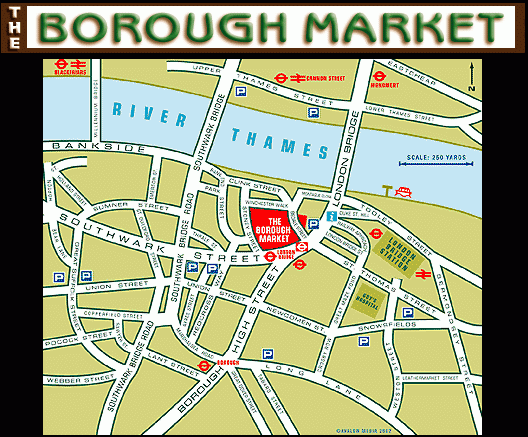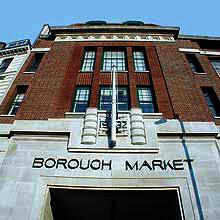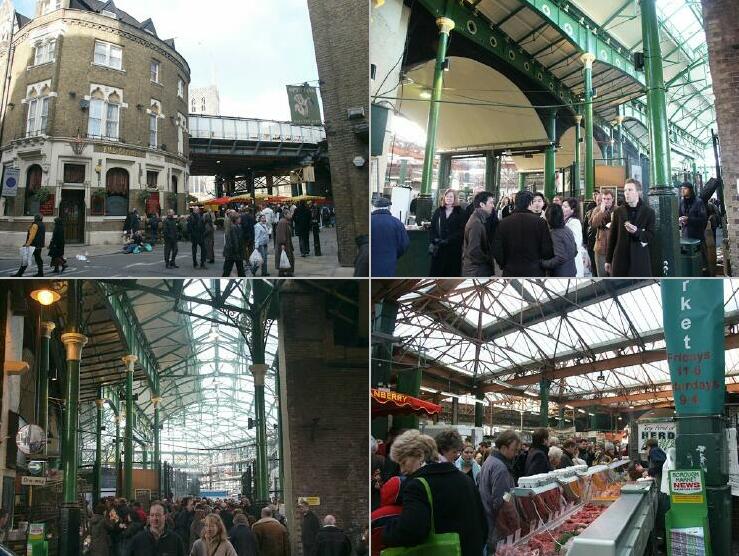(Return to "Out
and About" albumn)
(Return to "Dear
Diary #09")---(Return
to "Dear Diary #21")
The Borough Markets
(established for
over 2000 years!!!)
Email from
Tanya on Monday 29th March 2004
"Saturday
I got up and went shopping
I had to buy a sleeping bag to take to Turkey
so I got a good one from Katmandu as they were having a "half-price-sale"
I got it for £25 which was nice
Then I met Jaci and her sister at the Borough Markets near London
Bridge
Mum, you would go nuts there
I am going to go back and get some photos it was so good
Jaci said that Jamie Oliver shops there but I didn't run into
him!"
Email from Tanya
on Friday 22nd April 2005
"I am going
to the Borough Markets again tomorrow with Leslie
Looking forward to this
- cheeses and breads and organic veg and great cakes and exotic
wines
- mmmmmmm!!
It's also where Jamie Oliver shops"

Borough Market is situated
on the south side of London Bridge Mainline Station
It's only a 5 minute walk from the station to The Market at 8
Southwark Street SE1
It covers an area of 4.5 acres close to the southern end of London
Bridge in Southwark
Transport is covered in all directions by mainline trains, Underground
trains,
buses and even boat from the River Thames
 The history of the Markets
The history of the Markets
Southwark - sometimes called
the Borough - is the most ancient of London areas with a history
much older than the ‘Thorney Isle’ which afterwards
became Westminster.
Before the Romans came, Southwark Fair Market flourished on the
southern side of the river but no bridge of any kind existed to
link the two banks.
Aulus Plautus and his Roman legions found the market at Southwark
in AD 43 on their way to sack the city, but Plautus was no writer
and there was no written record until two centuries later - when
Dion Cassius told the story of this early Roman invasion.
To cross the Thames the Romans built the first London Bridge and
the Borough Market has always either been active trading on it
or positioned very close to southern end.
‘Southwark’ itself is first mentioned by name in AD
944 when it is recorded that the Saxons built a wooden bridge
at the southern end of which they erected a ‘Suthringagewoerc’
or military encampment to defend the city from invasion.
The first formal record of the market was on the bridge built
by King Canute in AD 1014 after the previous bridge was destroyed
by Norsemen in an attempt to lay siege to London.
Mention is first made of Borough Market as a recognised institution
in 1276, when it caused great inconvenience by causing congestion
on London Bridge.
A series of Royal Charters were passed by Edward III in 1406,
1442 and 1462.
Although the Borough Market has moved locations by a few hundred
yards either side from the southern bridgehead of London Bridge
it has always existed in roughly the same location.
It is now the oldest fruit and vegetable wholesale market still
trading from its present 4.5 acre site - since 1756 - in Central
London.
Records traced back to AD 1014 show that the market then sold
fish, grain & cattle - as well as vegetables and because of
it’s central location (the meeting points of all roads from
the South Coast & Southern Counties into the City of London)
merchants from all over Europe would travel from coastal ports
to tradein this market.
They would rest for the night in one of the many inns in Southwark,
the best known of which was the ‘Tabard Inn’ featured
in Chaucer’s ‘Canterbury Tales’.
As well as being a meeting place for merchants, Southwark had
an unenviable reputation for crime and it was not uncommon for
fighting to spill out of the inns into the street, a frequent
number of murders being the result.
At the height of the Victorian era most of the food imported to
the capital of the British Empire arrived at wharves alongside
London Bridge and Tooley Street - hence it’s name - ‘London’s
Larder’ and later on via London Bridge railway station, (the
first large railway terminus in Central London).
Thousand of tons of produce was wheeled the few yards from the
train to the Market.
Borough Market has survived for 20 centuries, and remains a centre
of food excellence.
We are looking forward to another 2,000 years of trading!


 The history of the Markets
The history of the Markets